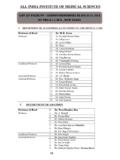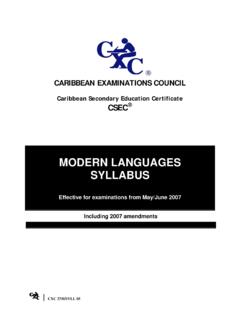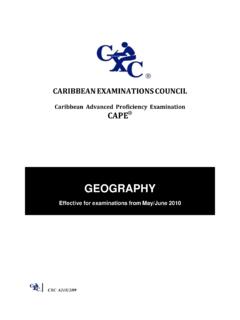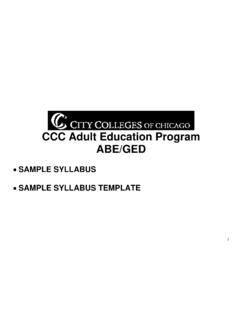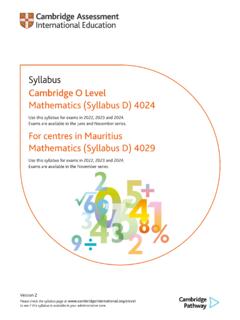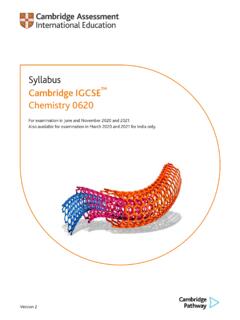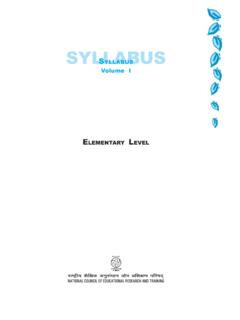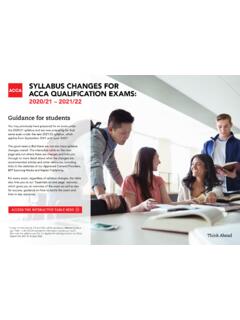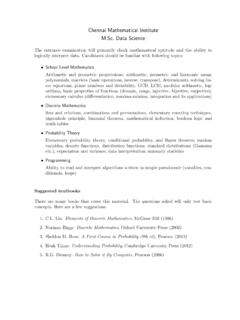Transcription of Syllabus - MBBS
1 All India Institute of Medical SciencesAnsari Nagar, New Delhi- 110029 SyllabusMBBSat the AIIMSS yllabusMBBSat theAIIMS iiiiiSyllabusMBBSat theAIIMSAll India Institute of Medical SciencesNew Delhi - 110 029ivAcademic AffairsConcerned OfficialsDr. P. Venugopal DirectorDr. Kusum Verma Dean (Acad.)Dr. Singh Dean (Exam.)Dr. Nikhil Tandon Sub-Dean (Acad.)Dr. Deepak Professor-in-charge (Exam.)Shri Gupta Registrar All India Institute of Medical Sciences, 2003 First edition 2003 Second edition July 2005 Typset and Printed by :Saurabh Printers Pvt. Ltd. B-280, Okhla Industrial Area, Phase-I, New Delhi-110020vSYLLABUS Kusum VermaChairpersonProf. & Head, Department of of the Department of of the Department of of the Department of of the Department of of the Department of Forensic of the Department of of the Department of of the Department of PaediatricsMember10. Head of the Department of SurgeryMember11. Head of the Department of Obst.
2 & Head of the Department of Community MedicineMember13. Head of the Department of PsychiatryMember14. Head of the Department of Derma. & Head of the Department of OrthopaedicsMember16. Head of the Department of ENTM ember17. Head of the Department of OphthalmologyMember18. Head of the Department of AnaesthesiologyMember19. Dr. Adkoli, CMETM ember20. Dr. Joshi, Sub-Dean (Acad.)Member21. Shri Gupta, RegistrarMember-SecretaryviPREAMBLEThe Health Survey and Development Committee, popularly known as the Bhore Committee, in itsreport published in 1946, recommended very strongly the establishment of a national medicalcenter at Delhi which will concentrate on training of highly qualified teachers and research workersin order that a steady stream of these could be maintained to meet the needs of the rapidly expandinghealth activities throughout the country. After the attainment of independence the Union Ministry ofHealth proceeded to implement this challenging idea and a magnificent grant of one million poundsby the Government of New Zealand through the Colombo Plan helped to translate the idea intoreality.
3 An act of Parliament in 1956 established the All India Institute of Medical Sciences as anAutonomous Institution of National importance and defined its objectives and prime concern of the Institute is to develop patterns of teaching in undergraduate andpostgraduate medical education in all the branches so as to demonstrate a high standard of medicaleducation to all medical colleges and other allied institutions in India. This educational experienceis imparted in an atmosphere of virtue of the Act, the Institute grants its own medical degrees and other academic degrees granted by the Institute under the All India Institute of Medical Sciences Act arerecognized medical qualifications for the purpose of the Indian Medical Council Act and,notwithstanding anything contained therein, are deemed to be included in the first schedule of thatAct, entitling the holders to the same privileges as those attached to the equivalent awards from therecognized Universities of India Syllabus for MBBS has been developed in consultation with the faculty of the concerneddepartments and further scrutinized by the Academic Section under the supervision of the Dean(Prof.)
4 P. Venugopal).viiCONTENTSS. Medicine & Toxicology .. & & Gynaecology .. India Institute of Medical Sciences (AIIMS) was established by the Act of Parliament in 1956 as anautonomous institute to set patterns in Undergraduate and Postgraduate Medical Education in all itsbranches to so as to demonstrate a high standard of medical education. This is the only institute outsidethe jurisdiction of Medical Council of India to encourage experiments in the curriculum. The Courseleading to the Degree of MBBS has been in existence since 1956. It mainly follows a disciplinarystructure. However, since inception, AIIMS has been constantly upgrading its course content in tunewith the changing needs. Many alterations have taken place during the last fifty years, which have beenreflected in the present curriculum MBBS course comprises four and a half years, followed by compulsory rotatory internship of oneyear.
5 The course follows semester system, each semester consisting of six months. The MBBS courseis divided in to three phases, viz., Pre-clinical, Para-clinical and Clinical Phase, during which followingsubjects are introduced:PhaseSemestersSubjects coveredPre-clinical1 2 : Two SemestersAnatomy, Bio-chemistry, PhysiologyPara-clinical3 5 : Three SemestersCommunity Medicine; Forensic Medicine,Pathology, Pharmacology, Microbiology, Clinicalpostings in wards, OPDs to begin here;Clinical6 9 : Four SemestersCommunity Medicine, Medicine and alliedsubjects (Psychiatry, Dermatology); ; Pediatrics;Surgery and allied subjects (Anesthesiology, , Ophthalmology, Orthopedics);Clinical postings;INTRODUCTIONixExamination ScheduleThere shall be three professional examinations as follows:First Professional of 2nd SemesterSecond Professional of 5th SemesterFinal Professional of 9th SemesterIn addition, Mid Semester, End Semester Examinations and End posting assessments are total weightage to the internal assessment is 50%, both in the theory and practical and objectives of undergraduate course (MBBS)At the end of the MBBS course, the learner shall be able to:1.
6 Diagnose and manage common health problems of the individual and the community appropriate tohis/her position as a member of the health team at primary, secondary and tertiary levels;2. Be competent to practice preventive, promotive, curative and rehabilitative medicine in respect tothe commonly encountered health problems;3. Practice Evidence Based Medicine, appreciating the rationale for different therapeutic modalitiesand be familiar with the administration of essential drugs and their common side effects;4. Appreciate the psycho-social, cultural, economic, and environmental factors affecting health, anddevelop humane attitude towards the patients/relatives, in discharging one s professionalresponsibilities;5. Be familiar with the various National Health Programs, and the ways in which they are beingimplemented;6. Acquire basic management skills in the area of materials, financial and human resources;7.
7 Demonstrate communication skills, both verbal and written to establish effective communicationwith the clients (patients, relatives, and general public), health team partners, and scientific community;8. Practice medical ethics in patient care, service delivery, and Develop attitude for self learning and acquire necessary skills including the use of appropriatetechnologies, for pursuing self directed learning for a life duration of course is one year. It comprises of two semesters I and II. Each semester is of sixmonths commences from 1st August every year and ends on 15 June following subject of anatomy is taught under the following heads :1. Gross anatomy2. Microanatomy3. Embryology and Genetics4. NeuroanatomyTotal number of teaching hours are approximately of teaching hours for theory and practicals are as follows :SubjectApproximate No. of hours taught1. Gross AnatomyLectures38 Practicals3492.
8 MicroanatomyLectures20 Practicals433. EmbryologyLectures21 Practicals18 GeneticsLectures5 Practicals12 Syllabus MBBS AIIMS4. NeuroanatomyLectures19 Practicals27 Total No. of teaching hours in Anatomy541(Theory and Practicals)OBJECTIVESAt the end of the course, the student should be able to: Comprehend the normal disposition, inter-relationships, gross, functional and applied anatomy ofthe various structures in the body. Identify the microscopic structures of various tissues, and organs in the human body and correlatethe structure with the functions as a prerequisite for understanding the altered state in variousdisease processes. Comprehend the basic structure and connections between the various parts of the central nervoussystem so as to analyze the integrative and regulative functions on the organs and systems. He/Sheshould be able to locate the site of gross lesions according to the deficits encountered.
9 To understand the basic principles of embryology including genetic inheritance and stages involvedin development of the organs and systems from the time of conception till birth. The student shouldrecognise the critical stages of normal development and the effects of common teratogens, geneticmutations and environmental hazards on it. He/She should be able to explain the developmental basisof the occurrence of major variations, abnormalities and congenital CONTENT1. Gross AnatomyIntroduction to Anatomy, nomenclature, anatomical position, planes, tissues and Osteology(a) Names of the bones of the body and their position; classification of the bones with examples;general features of the bone and normal development; microscopic anatomy of bone; general patternof blood supply; ossification of the bones of the limbs for age determination. X-rays of bones.(b) Process of repair of Muscular System(a) Classification and identification of the muscles of the body: main attachments, nerve supply andaction(s), microscopic anatomy of muscles and the nerve terminations.
10 (b) Details of attachments of the muscles; ultrastructural features of muscle; mechanism of the movementcaused by the muscle/muscles and various forces exerted by them and their detailed action(s).3. Arthrology(a) Definition and classification of joints, general features of different types of joints; detailed study ofmajor joints of the limbs and movements performed at various joints in the (b) Microscopic anatomy of articular cartilage; maintenance of articular cartilages; blood supply andnerve supply of the Cardio Vascular System(a) Normal position, external features and parts of the heart; internal features of the chambers of heart,names of the blood vessels and venous drainage of the organs, structures and body as a whole,conducting system of heart, fibroskeleton of heart.(b) Variation(s), developmental anomalies of heart and blood vessels, valvular defects and their effectsin pathogenesis of the Respiratory System(a) Position, parts, relations, blood supply of upper and lower respiratory tract.


